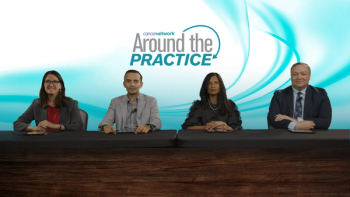
Quadruplet Regimens for Transplant-Eligible Multiple Myeloma
Implications of updated data from the GRIFFIN trial, in terms of using quadruplet therapy to manage patients with newly diagnosed multiple myeloma who are eligible for transplant.
Episodes in this series

Saad Z. Usmani, MD: What are the available triplet and quadruplet regimen options for patients? Are there any new data that influence your decision-making? You’ve briefly mentioned the GRIFFIN trial. You talked about the FORTE trial as well. But there are other studies, like MASTER, that have combined a carfilzomib [Kyprolis]–based triplet regimen with the daratumumab [Darzalex]. Sham and Urvi can talk a bit about the GRIFFIN data. Neha, maybe you could take on the KRd [carfilzomib, lenalidomide, dexamethasone] trial. What do you think, Sham?
Sham Mailankody, MD: I think the GRIFFIN trial is a nice study. It’s a randomized phase 2 study and is a cooperative group study, so it broadly represents what we see in the community in terms of patients with newly diagnosed myeloma. It’s a study that looks at randomizing patients with newly diagnosed myeloma to RVd [lenalidomide, bortezomib, dexamethasone], which is the default standard of care, vs daratumumab with RVd [lenalidomide, bortezomib, dexamethasone]. Those were the 2 choices.
Most people went to transplant and then maintenance after treatment for 2 years. The maintenance was lenalidomide [Revlimid] for the patients who got RVd [lenalidomide, bortezomib, dexamethasone], and daratumumab-lenalidomide for patients who were randomized to daratumumab–RVd [lenalidomide, bortezomib, dexamethasone]. It’s 2 years of maintenance, and the study was updated at ASH [American Society of Hematology Annual Meeting]. We heard updates from Dr Jacob Laubach looking at 2-year follow-up results, and they look very good. The CR [conversion rate] rates, the MRD [minimal residual disease]–negativity rates, and the sustained MRD-negativity rates are about 2 to 3 times higher in the quadruplet regimens compared with the triplet regimens. This was true across many subsets; therefore, there’s enthusiasm for adding daratumumab.
Historically, if you look at how treatments with large-cell lymphoma have evolved, we started with the CHOP [cyclophosphamide, hydroxydaunorubicin hydrochloride, vincristine, prednisone] regimen for many years, and then we got an effective antibody, like a CD20 antibody. Obviously R-CHOP [rituximab, cyclophosphamide, hydroxydaunorubicin hydrochloride, vincristine, prednisone], the last time I checked lymphoma data, was the standard of care. It’s a similar concept with myeloma. We might want to wait a little longer for some ongoing studies to read out—which should be soon—in terms of whether we do this for all patients. Are we going to select some patients based on cytogenetics or other factors? It wouldn’t surprise me if more patients get quadruplet regimens, particularly if they are young or have high-risk cytogenetics or other factors.
The GRIFFIN study is both the initial presentation and publication, about a year back. The follow-up data consistently show good results for these quadruplet regimens. I was going to ask about an early start on maintenance. Because there are doublet regimens vs singlet regimens, how do we think about the GRIFFIN trial and maintenance for patients who go with quadruplet regimens?
Saad Z. Usmani, MD: In the GRIFFIN trial, Urvi, there was no randomization. They got
daratumumab.
Urvi Shah, MD: That’s a good point. The issue is that there’s a PFS [progression-free survival] benefit with GRIFFIN, and we’re talking about not just a quadruplet induction but a doublet maintenance as well. Which part is driving this increase in PFS? Is it the up-front quadruplet induction, or is it the doublet maintenance? Do we need both? Do we need the daratumumab from induction to maintenance, or can we just do it in the induction phase, stop, and just have Revlimid as maintenance? That question is unanswered. Some studies from the Alliance Myeloma Committee is looking at this. Data will give us more answers because putting a patient on a monthly daratumumab shot with Revlimid is a significant quality-of-life hit because they’re coming in monthly vs every 3 months with Revlimid.
The other thing is they saw an improvement in MRD negativity from the study that went from 1 end of consolidation on the daratumumab–RVd [lenalidomide, bortezomib, dexamethasone] arm, 50%, to about 64% at 24 months postmaintenance. On the RVd [lenalidomide, bortezomib, dexamethasone] arm, it went from 20% to 30%. Both arms have deepening response. Even with a single-drug maintenance, we’re seeing some deepening by 10%. On the other arm we’re seeing a 14% deepening. If we look at it that way, there’s not a much higher deepening with the doublet regimen compared with a single drug.
Saad Z. Usmani, MD: Two other studies compare daratumumab–RVd [lenalidomide, bortezomib, dexamethasone] with RVd [lenalidomide, bortezomib, dexamethasone] in transplant-ineligible and eligible settings, which will probably shed more light. In the US cooperative group setting, there’s a large study that’s looking at lenalidomide maintenance questions. There are going to be patients treated with quadruplet inductions going on in that study. The other cool thing I like about the maintenance question is that now we have trials that are looking at sustained MRD as a talking point, right? We’re able to define the duration of treatment for our transplant-eligible patients. What do you think about the KRd [carfilzomib, lenalidomide, dexamethasone] data since?
Neha Korde, MD: Looking at the next question, about the MASTER study, this is a brilliantly designed study. It’s innovative. It’s new. One thing I love about this study is that we’re able to assess whether patients can get off what I call the maintenance roller coaster, which is endless therapy impacting quality of life. Whether we like to admit it or not, even patients prescribed an oral pill have significant quality-of-life issues.
When you look at the MASTER design study designed by Dr Luciano Costa and colleagues, what they’re doing is giving daratumumab–KRd [carfilzomib, lenalidomide, dexamethasone] up front, followed by consolidation with transplant, and then another round of 0 to 8 cycles of consolidation. They do it in blocks and then essentially look at MRD assessments after every block after consolidation. If you have 2 consecutive MRD-negative time points, they take those patients off-study and then call them “MRD sure,” which means these patients are MRD negative. We’d like to follow their MRD status off-therapy.
The nice part about this study is that they took the time to stratify patients according to risk category, so we understand a bit about those high-risk patients and how sustainable their MRD negativity can last over this time period. We’ll hopefully get ASH updates soon. Based on the MASTER trial abstract, it looks like close to 70% of patients are able to come off therapy and enter this “MRD sure” state. This is great.
One other thing I’d like to bring up, with regard to the maintenance question and doublet regimens vs taking patients off drug therapy, is that at this time, during the COVID-19 pandemic, this couldn’t be more relevant. Our patients are immunosuppressed, and a lot of the data that we’re looking at show that if you’re on an anti-CD38, for instance, you want responses to your vaccines. This question is so relevant. It will be great for us to get some of this information.
Saad Z. Usmani, MD: That’s an excellent summary of the KRd [carfilzomib, lenalidomide, dexamethasone] data and where things are headed.
Transcript edited for clarity.
Newsletter
Stay up to date on recent advances in the multidisciplinary approach to cancer.
































































































